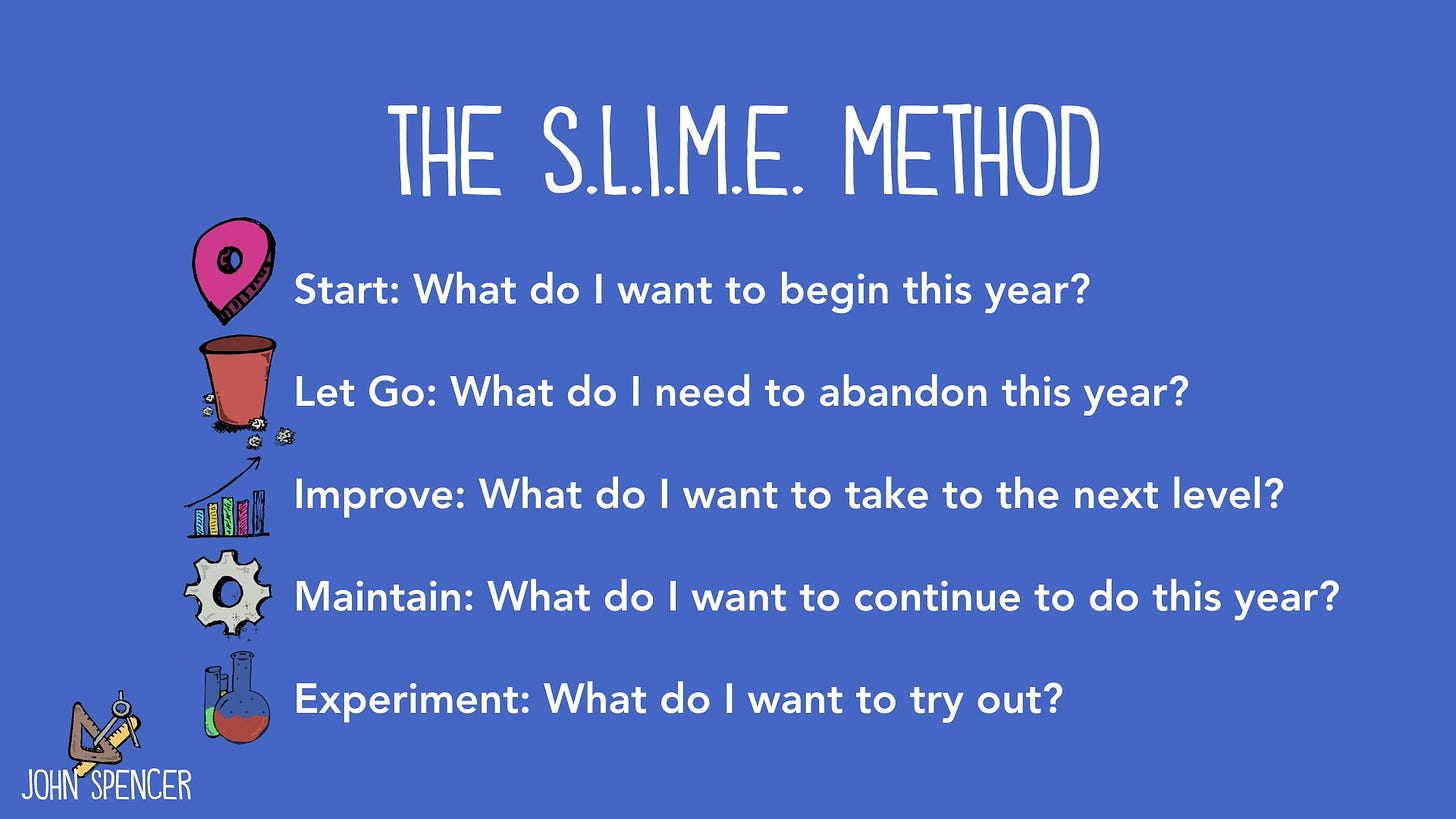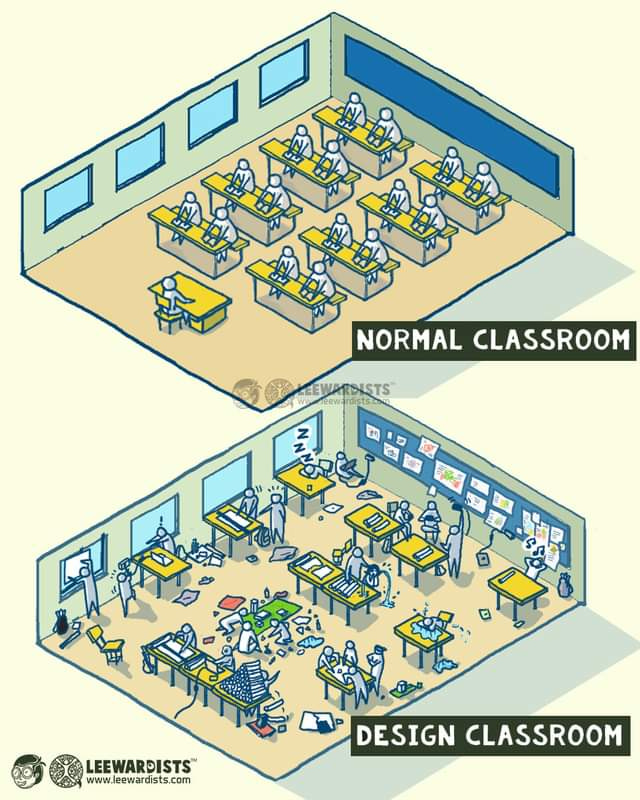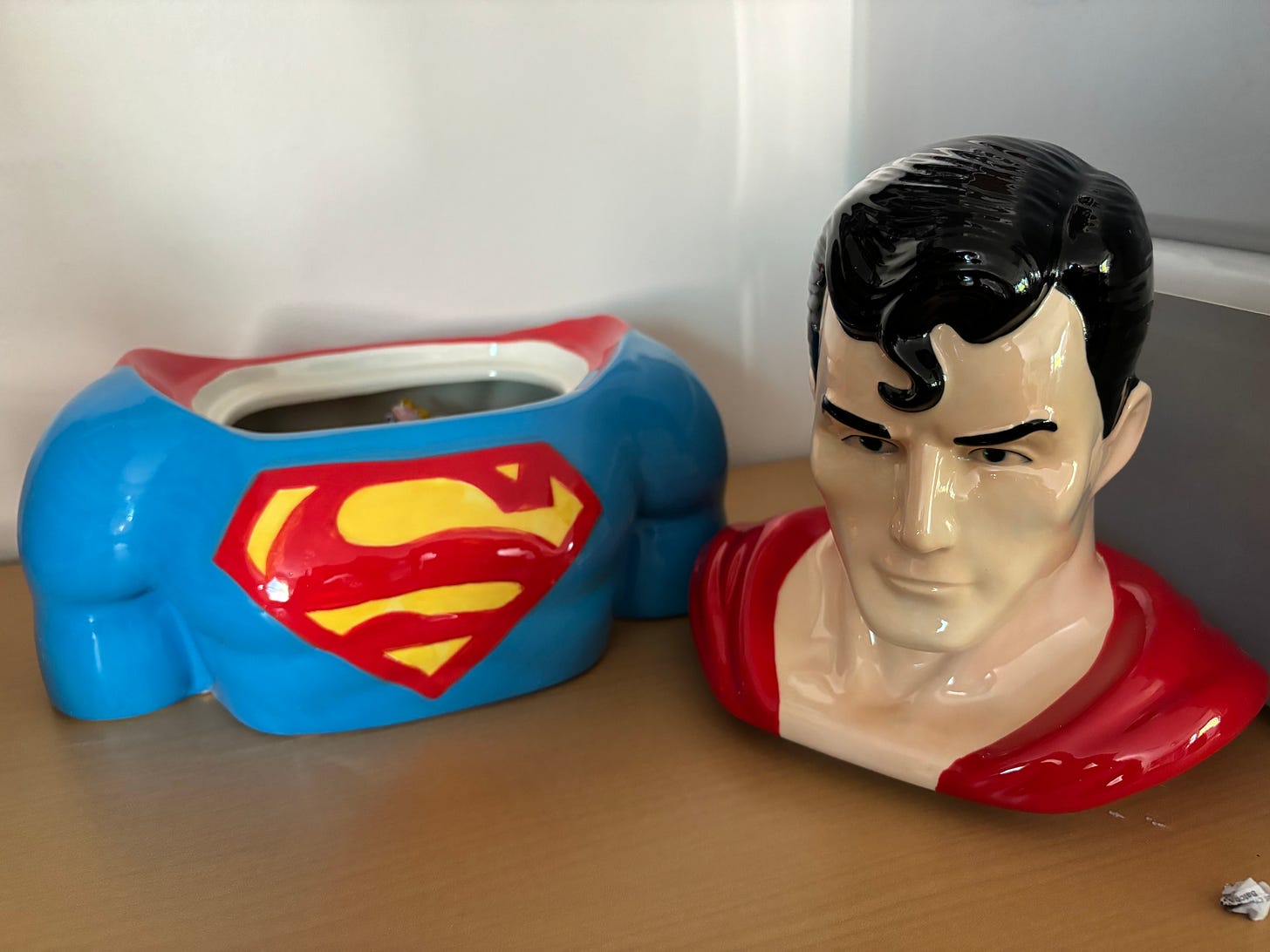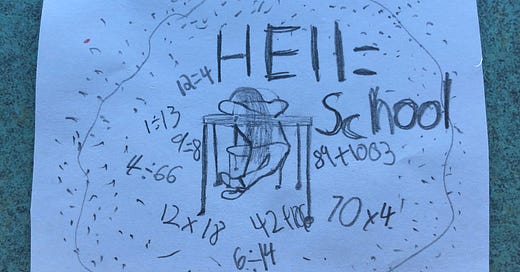

Discover more from Adrian’s Newsletter

Happy New Year!
I’ve never been good with resolutions. Whenever I try to set one, it feels artificial; like I’m creating a superficial rule just to set one. Instead, I try to be better every day. I try to make good choices and live up to the expectations I set for myself. Sometimes I fall short. Sometimes I fail miserably. As long as I pick myself up, dust myself off, and try to be better tomorrow than I was today, I’m content.
Before Christmas, I had my students use John Spencer’s SLIME Method to set New Year’s Resolutions. I love how instead of setting one goal, Spencer has you create multiple goals: something to start, abandon, improve, maintain, and experiment.
I combined this with vision boards, having students create a slidedeck with their SLIME resolutions and lots of pictures that will inspire them in the new year.
One evening, I shared this activity with my family. We all had fun sharing our individual SLIME resolutions. The one that stuck with me was Let Go. What do I need to abandon this year? Notice, Spencer didn’t say want to abandon this year, but need to.
So, in the spirit of abandoning things that are not good for you, here are five things I want to let go of in the new year.
1. Grades
At the beginning of this year, I experimented with ungrading. According to Jesse Stommel, author of Undoing the Grade: Why We Grade, and How to Stop, ungrading means “raising an eyebrow at grades as a systemic practice, distinct from simply ‘not grading.’ The word is a present participle, an ongoing process, not a static set of practices.” For the first trimester, I set out to measure my students’ learning through conversations, conferences, and qualitative feedback.
While I am required to give a standards-based a grade at the end of each trimester, I did not grade every individual assignment, but rather asked lots of questions and made a ton of comments that engaged my students in their work rather than simply evaluate it.
It’s been a success. I feel like my students are learning more, especially in writing, due to the conversations we have been having. So, for the rest of this school year (and into 2024), I want to fully abandon grades, having my students continue to reflect carefully on their own work and the work of their peers.
Here is Stommel discussing ungrading with the BIG Questions Institute.
2. Curriculum Mapping
What is the purpose of a curriculum map? Let’s think about that for a minute. The academic definition tells us that “curriculum mapping is the process of indexing or diagramming a curriculum to identify and address academic gaps, redundancies, and misalignments for purposes of improving the overall coherence of a course of study and, by extension, its effectiveness” (Hidden curriculum, 2014). Nicholas Carr, in The Glass Cage, explores the human impact of automation. He describes how Google Maps has made people lazy at reading maps. We are no longer wayfaring; just focusing on the destination.
Teachers have lost their wayfaring skills. They use curriculum maps in the same way we use Google Maps: finding the way when lost in a mess of standardized curricula. Instead of immersing themselves in the landscape of their curriculum content, noticing its unique features and landmarks, they lose their “mental mapping skills” no longer able to make connections between content areas. Even less frequently, especially at the elementary level, each subject is taught as separate curricular units instead connected concepts. This prevents teachers from creating opportunities for students to make their own connections between academic content.
Any new curriculum is overwhelming and burdensome to teachers. Oftentimes, the specified pace is too demanding and leads to frustrations and time-consuming menial tasks.
This year, I’m going to abandon my curriculum maps. I’m going to focus on my students’ learning and the pace at which it happens. I’m going to simplify the focus of each of my learning experiences.
Something that I’m exploring is the concept of curriculum storyboarding. Listen to Heidi Hayes Jacobs discuss the shift from curriculum mapping to storyboarding.
3. Classroom Management
I’ve never been good at classroom management. I’ve tried a number of different management systems and they always fail. In fact, my classroom oftentimes resembles the design classroom instead of the traditional classroom shown above. It has taken me a long time to understand why: I hate blind compliance.
I do not believe in managing my students into quiet compliance. My goal is to teach my students about accountable freedom. The concept of accountable freedom is made up of two main elements:
Accountability - giving students the opportunity to exercise personal choice and judgment around what they do and how they solve conflict.
Freedom - the opportunity for students to make decisions within an agreed framework that works for both me as teacher and my students.
This means that instead of micromanaging my students’ behavior in the classroom, I focus more on giving them grace and the benefit of the doubt. I want my students to have an active role in how problems are solved. I use restorative conversations to resolve conflicts and learn how to establish trust between me and my students. I use Dr Brené Brown’s BRAVING Framework to monitor our collective learning and create a safe learning environment.
This year, I’m abandoning the idea of trying to control my students. Yes, there will be times when I need to redirect misbehavior, but overall, I’m finished micromanaging my students.
4. Paying students for positive behavior
This is related to my classroom management practices. Every school that I’ve worked for has some sort of external reward system: stickers, fake money, points, stars. Students who are behaving properly earn points that can be cashed in for prizes at a classroom or school store. The problem with these practices is that they are inequitable and reward compliance instead of critical thinking. A White student who is sitting quietly filling out a worksheet receives five points. A Black student who is discussing the content of a particular lesson with a peer, but it not filling out the worksheet is often scolded or redirected to be quiet and complete the task. They may even lose points for speaking.
These types of reward systems have never worked in my class. By the time students get to my fifth-grade classroom, they see the inequity (and also the ridiculousness) of trying to earn recognition in order to buy a plastic toy at the end of the month. Instead, I find that genuine gratitude and public recognition of the types of positive behaviors and thinking I want is more effective. Jolly ranchers work, too! Students love the instant gratification of receiving a piece of candy for thinking critically, being a leader, and learning by showing growth.
This video does a great job breaking down the limitations of token economies.
5. Basal Readers
This year, our school district implemented a new reading curriculum that uses basal readers. Basal readers are textbooks used to teach specific reading skills such as finding the main idea, summarizing, and inferencing. I hate basal readers.
Following a reading curriculum, using a textbook and worksheets, deprives my students the ability to interact with real books. Instead of book clubs where students are discussing a particular scene or chapter or theme, students now read a short article or excerpt from a story, answering comprehension questions at the end.
I’ll admit, sometimes these premade lesson plans can come in handy, especially for a substitute teacher. I can just copy the lesson and the worksheets and the substitute can follow the script. It takes very little craft to execute one of these standardized lessons. Research shows that basal reading programs focus too much on discrete skills and reading strategies. In fact, they “distract students and sidetrack them into thinking about decoding, structural analysis, fail[ing] to support students in understanding the central meaning of the text (McKeown, Beck, & Blake, 2009). Students are stuck focusing only on surface-level details of any given text, instead of delving deep into author’s purpose and craft (McKeown & Beck, 2006).
I’m abandoning basal readers in my classroom. I’m sure that I will be forced to use them periodically as part of our district’s effort to teach the curriculum “with fidelity.” However, I’m planning to favor novel studies and book clubs more. I want my students to read books, discuss books, and fall in love with characters and stories from books.
I’m looking forward to letting go of each of these classroom practices. I don’t know what 2024 has in store for me and my classroom, but I’m hopeful that abandoning these practices helps me create a more authentic and positive learning environment.
Here’s to a healthy new year. Have a great week!
— Adrian
Need some final words of wisdom? Look no further than Matthew McConaughey!

















